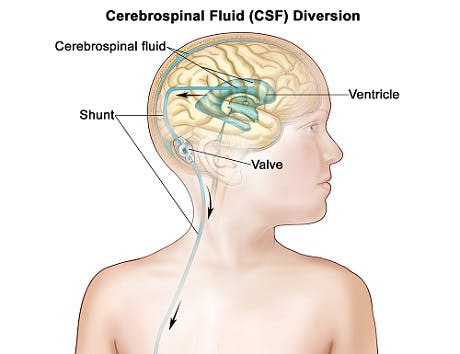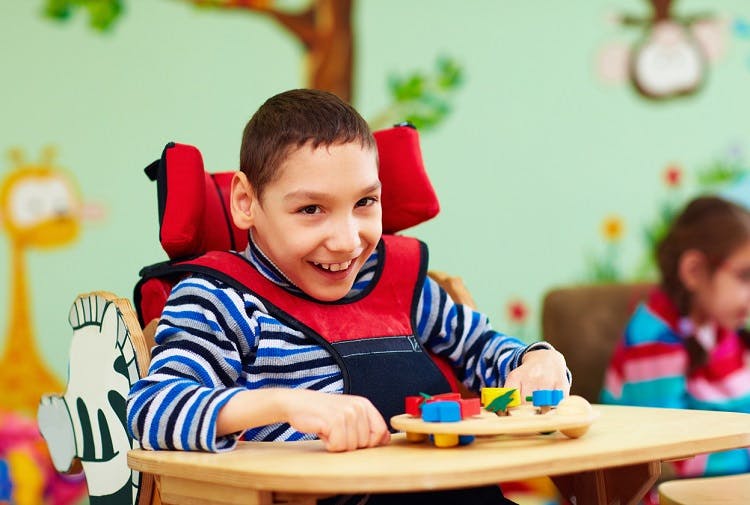About 15% of children with cerebral palsy have hydrocephalus. Hydrocephalus is a medical condition that describes the excess accumulation of cerebrospinal fluid (CSP) in the brain. CSP is the fluid that surrounds the brain and spinal cord.
While it is essential for protection, nutrients, and waste removal, excess amounts of CSP in the brain can cause the head to expand, increase pressure in the brain, and cause permanent tissue damage.
This article will explain the relationship between hydrocephalus and cerebral palsy, signs to be aware of, and effective treatments to minimize damage.
What’s the Link Between Hydrocephalus and Cerebral Palsy?
Hydrocephalus and cerebral palsy can develop independently of each other. However, hydrocephalus can also be a cause and secondary effect of cerebral palsy.
Cerebral palsy is a motor disability caused by damage to the brain before, during, or shortly after birth.
Hydrocephalus may develop prenatally (before birth) to an extent where damage to the brain (which may cause CP) has already occurred by the time a child is born. Other times, premature birth, infection, or trauma to the brain during or shortly after birth may result in acquired cerebral palsy and secondarily cause hydrocephalus.
Generally, the more severe the damage to the developing brain, the greater the risk of having both hydrocephalus and cerebral palsy.
Hydrocephalus can be divided into two categories, obstructive and communicating. Obstructive hydrocephalus occurs when passageways within the ventricular system of the brain are blocked. In contrast, communication hydrocephalus occurs when CSF cannot be absorbed back into the bloodstream.
Both forms of hydrocephalus cause CSF buildup in the brain, which may damage the tissues and cause cerebral palsy. Additionally, if hydrocephalus is not diagnosed and treated early enough, it could be fatal.
Because of these significant risks, it’s crucial to identify early signs and symptoms of hydrocephalus and seek treatment as early as possible. In the following section, we’ll explain common signs and symptoms of hydrocephalus.
Signs and Symptoms of Hydrocephalus
Hydrocephalus may range from mild to severe. Depending on its severity, individuals may demonstrate various symptoms.
Likewise, hydrocephalus may present itself differently depending on one’s age. For example, infants commonly present with progressive macrocephaly (an excessively enlarged head). This is because the fibrous tissues in between the bones that make up the skull (sutures) are softer and not fully fused together yet. As children reach about 2 years, the sutures fuse together and harden into bone. Children older than 2 years generally exhibit symptoms of intracranial hypertension (high pressure in the brain).
Common signs and symptoms of hydrocephalus include:
- Rapid head growth
- Abnormal head shape
- Bulging on the surface of the head
- Increased deep tendon reflexes and muscle tone in lower extremities
- Growth failure
- Impaired head and trunk control
- Developmental delays
- Feeding disturbances
- Seizures
- Increased irritability
- Lethargy
- Sunsetting eyes (downwards deviation of the eyes)
- Headache, nausea, vomiting (often worst in the morning because intracranial pressure is highest when individuals are reclined for prolonged periods)
- Vision problems
- Poor coordination and balance
Many signs and symptoms of hydrocephalus are similar to those of cerebral palsy including high muscle tone, abnormal growth, developmental delays, and feeding disturbances.
If you notice any of these signs, seek a professional diagnosis. Early identification and treatment of hydrocephalus are critical for minimizing damage. Up next, we’ll discuss treatments for hydrocephalus.
Treatments for Hydrocephalus

Treatments for hydrocephalus primarily focus on reducing the amount of cerebrospinal fluid in the brain.
The most widely used treatments for hydrocephalus are shunt implantation and endoscopic third ventriculostomy. Both treatments require surgical intervention and while they won’t affect the absorption or production of cerebrospinal fluid, they both displace the amount of fluid in the brain.
A shunt is a tube that allows CSF from the brain to move into the chest cavity or abdomen where it is reabsorbed back into the bloodstream. While shunts are effective treatments for hydrocephalus, there are some risks associated with their use including relatively high infection rates and obstruction.
In contrast, endoscopic third ventriculostomy involves making a small incision in the third ventricle, which allows CSF to flow out of the ventricular system. Because the procedure does not involve implanting an object into the brain like a shunt, there is a lower risk of long-term complications.
With timely treatment, many individuals with hydrocephalus and cerebral palsy are able to have active, functional lives.
Hydrocephalus and Cerebral Palsy: Key Points
Hydrocephalus refers to the excess buildup of cerebrospinal fluid in the brain, which may damage the tissues and consequently cause cerebral palsy. However, the two conditions do not always occur together.
Both conditions may cause motor impairments and will benefit from early diagnosis and treatment.
We hope this article helped you understand the link between hydrocephalus and cerebral palsy.










